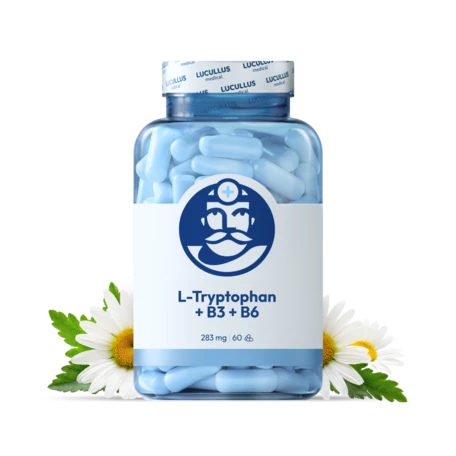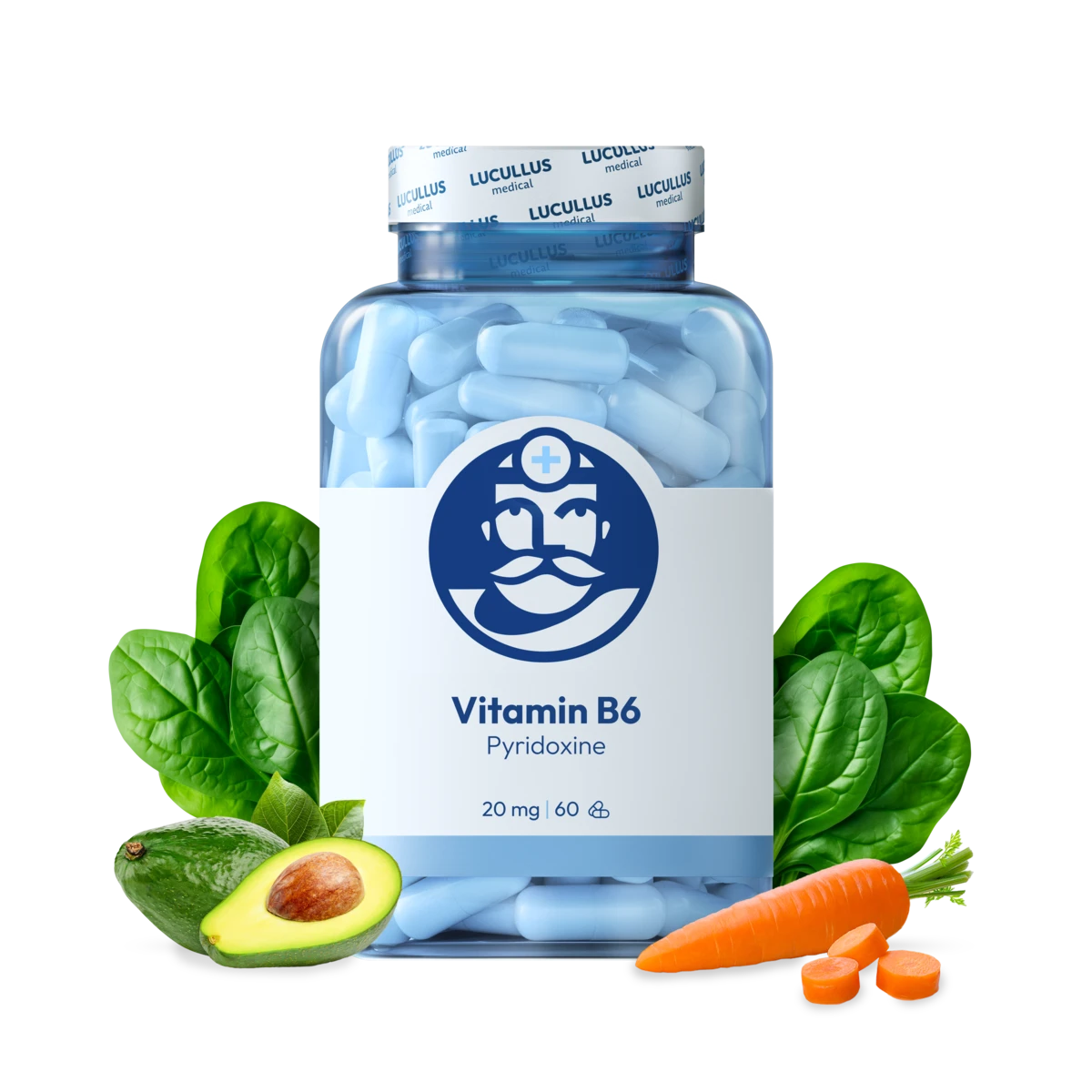
Účinky
Improved mood and serotonin productionIncreased sleep qualityReduction of stress and relaxationComprehensive support for the nervous systemNutritional balance and vitality
Pack of 60 capsules
| Active ingredient | In daily dose | % Ref |
|---|---|---|
| Vitamin B6 (pyridoxine hydrochloride) | 20 mg | 1428.57% |
Ingredients: Vitamin B6 (pyridoxine hydrochloride), bulking agent: magnesium carbonate, microcrystalline cellulose, capsule made from gelatin.
Discover a natural source of vitality and mental balance with pure and effective Vitamin B6
Fatigue, irritability and reduced focus are among the most common signs of vitamin B6 deficiency. This essential micronutrient is crucial for energy production, nervous system balance and proper immune function. Vitamin B6 in capsules provides a precisely dosed, highly absorbable form that supports optimal daily functioning.
Vitamin B6 acts as a coenzyme in more than 100 enzymatic reactions in the body – from amino acid metabolism to glucose regulation. It supports the synthesis of neurotransmitters such as serotonin, dopamine and GABA, influencing mood, memory and sleep quality. It helps convert glycogen into glucose, stabilizing energy levels throughout the day. It strengthens immunity and, thanks to high bioavailability, helps reduce fatigue, stress and supports mental clarity.
Take 1 capsule daily, ideally with food. Manufactured in Slovakia with emphasis on purity, safety and efficacy. It is non-GMO, gluten-free, lactose-free and free of colorants. Each batch is laboratory tested.
Restore your energy and mental freshness. Support your immunity, hormonal balance and emotional resilience naturally – with premium Vitamin B6.

Read the latest news about quality dietary supplements, vitamins, immunity, and health.

If you're active on social media, the term Milk Thistle is probably already familiar to you. It's a phenomenon of the year 2024, with adverts for this "miracle herb" everywhere. Unlike other dietary supplements, there is no one who doubts the effects of this plant. Opinions only differ on individual products and their processing methods. So what is the miracle of this thistle?

Vitamin B3 - niacin, perhaps the older ones also know it as vitamin P. It belongs to the group of B vitamins, which we find in the multiform B-complex. It is a very important group of vitamins that we necessarily need for the proper function of vision, mucous membranes, skin, heart... In the body, they are responsible for the production of energy in cells and are essential for the proper functioning of cardiac, muscle, and nerve activities.

For ages, people have been trying to find miraculous herbs and mushrooms that would enhance health, cure deadly diseases, and boost male potency. Each culture has its proven aphrodisiacs. Here, oysters or chocolate are especially well-known. Recently, especially with the development of tourism, we gradually also learn about other invigorating means that people use often on the opposite side of the planet. One of the oldest substances for potency support is Maca Peruvian Watercress.

Cordyceps sinensis - this is our zombie predator. In China, it is called "in winter insects, in summer herbs." Imagine a fungus that during reproduction in summer shoots its spores (seeds), which attach to the insect's body. It gradually grows throughout and parasitizes it, devours it from the inside out, with the insect still alive, even altering its outer appearance but still foraging until it retreats underground where it dies and mummifies. The fungus can survive in it for a longer period. The fungus literally controls the host's body, growing out of its body in summer, forming slender "sticks" 5-20 cm high. This inspired the video game series Last of Us where the Cordyceps fungus turns humankind into zombies. In real life, this video game unfolds in the actual life of insects. The victims are larvae of butterflies, large ants, spiders...

You definitely know the feeling when you're in danger. A big dog jumped out from behind a fence, your boss scolded you in a meeting, or you have a mortgage payment due tomorrow and just got laid off. In such cases, the body produces the steroid hormone - cortisol. It has protected us for centuries in dangerous situations, preparing the body for 'fight or flight.' The heart races, blood flows to vital organs, and pain levels are suppressed... You might say - the most useful thing under the sun!

Besides the well-known B-Complex mix of B vitamins, individual vitamins can also be purchased as solo supplements. Why is this good? The well-known set of B vitamins is a suitable dietary supplement if you have an overall deficiency of vitamins in the body. However, if you are dealing with a specific problem, it is sometimes more appropriate to reach for the exact type of vitamin you need to supplement. So why is vitamin B2 needed?